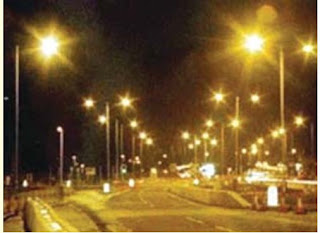Electrical Illumination Definitions
Light
it is defined as the radiant energy from a hot body which produce the visual sensation upon human eye. It is usually denoted by Q, expressed in lumen-hours and is analogous to watt-hours.
Luminous Flux(F or Ф)
It is defined as the total quantity of light energy per second from a luminous body.It is represented by symbol F or Ф and unit is lumen.
Approximate relation between lumen and electric unit of power i.e. watt is given as
1lumen=0.0016 watt(approx).Lumen-hour
It is the quantity of light delivered in one hour by a flux of a one lumen.
Luminous Intensity
Luminous intensity in any given direction is the luminous flux emitted by the source per unit solid angle,measured in the direction in which the intensity is required.It is denoted by symbol I and is measured in candela (cd) or lumen per steradian.
Lumen
The lumen is the unit of luminous flux and is defined as the amount of luminous flux given out in a space represented by one unit of solid angle by a source having an intensity of one candle power in all directions.
i.e. Lumens = Candel power X solid angle = CP X ധ or total lumen given out by source of one candle is 4π lumen.
Candle Power
Candle power is the light radiating capacity of a source in a given direction and is defined as the number of lumens given out by the source in a unit solid angle in a given direction. It is denoted by symbol CP.
Illumination
When the light falls upon any surface, the phenomenon is called the illumination.It is defined as the number of lumens, falling on the surface, per unit area. It is denoted by symbol E and is measured in lumen per square meter or lux or meter-candle.
If a flux of F lumen fall on a surface of area A, then the illumination of that surface is
E = F/A lumens/m sq or lux (lx).
Foot-Candle
It is also the unit of illumination and is defined as the luminous flux falling per square foot on the surface which is everywhere perpendicular to the rays of light from a source of one candle power and foot away from it.
i.e. 1 Foot-candle =1 lumen/ft sq.
Candela
It is the unit of luminous intensity.It is defined as 1/60th of the luminous intensity per cm2 of a black body radiator at the temperature of solidification of platinum (2,043 K).
Mean Horizontal Candle Power (MHCP)
It is defined as the mean of candle powers in all directions in the horizontal plane containing the source of light.
Mean Spherical Candle Power (MSCP)
It is defined as the mean of candle powers in all directions and in all planes form the source of light.
Mean Hemispherical Candle Power (MHSCP)
It is defined as the mean of candle powers in all directions above or below the horizontal plane passing through the source of light.
Reduction Factor
Reduction factor of a source of light is the ratio of its means spherical candle power to its mean horizontal candle power.
i.e. , Reduction factor = MSCP/MHCP.
Lamp Efficiency
It is defined as the ratio of the luminous flux to the power input. It is expressed in lumen per watt.
Specific consumption
It is defined at the ratio of the power input to the average candle power.It is expressed in watts per candela.
Brightness Or Luminance
Brightness Or luminance is defined as the luminous intensity per unit projected area of either a surface source of light or a reflecting surface is denoted by L.
L= I/AcosӨ (candela/m sq or nits)
i.e., nit is defined as candela per square meter.Bigger unit of luminance is stilb which is defined as candelas per square cm. Lambert is also the unit of brightness which is lumens/cm sq.Foot-lambert is lumens/ft sq.
L= I/AcosӨ (candela/m sq or nits)
i.e., nit is defined as candela per square meter.Bigger unit of luminance is stilb which is defined as candelas per square cm. Lambert is also the unit of brightness which is lumens/cm sq.Foot-lambert is lumens/ft sq.
Glare
Glare may be defined as the brightness with in the field of vision of such a character as to cause annoyance, discomfort, interference with the vision or eye fatigue.
Space-height Ratio
It is defined as the ratio of horizontal distance between adjacent lamps and height of their mountings.
i.e.,Space-height ratio= Horizontal distance between two adjacent lamps/Mounting height of lamps above working plane.
i.e.,Space-height ratio= Horizontal distance between two adjacent lamps/Mounting height of lamps above working plane.
Utilization Factor Or Cofficient of Utilization
It is defined as the ratio of total lumens reaching the working plane to total lumens given out by the lamp.
Maintenance Factor
i.e.,Utilization factor= Total lumen reaching the working plane/Total lumens given out by the lamp .
The ratio of illumination under normal working conditions to the illumination when the things are perfectely clean is known as maintenance factor.
i.e.,Maintenance factor= Illumination under normal working conditions/Illumination when everything is perfectely clean.
i.e.,Maintenance factor= Illumination under normal working conditions/Illumination when everything is perfectely clean.

No comments:
Post a Comment